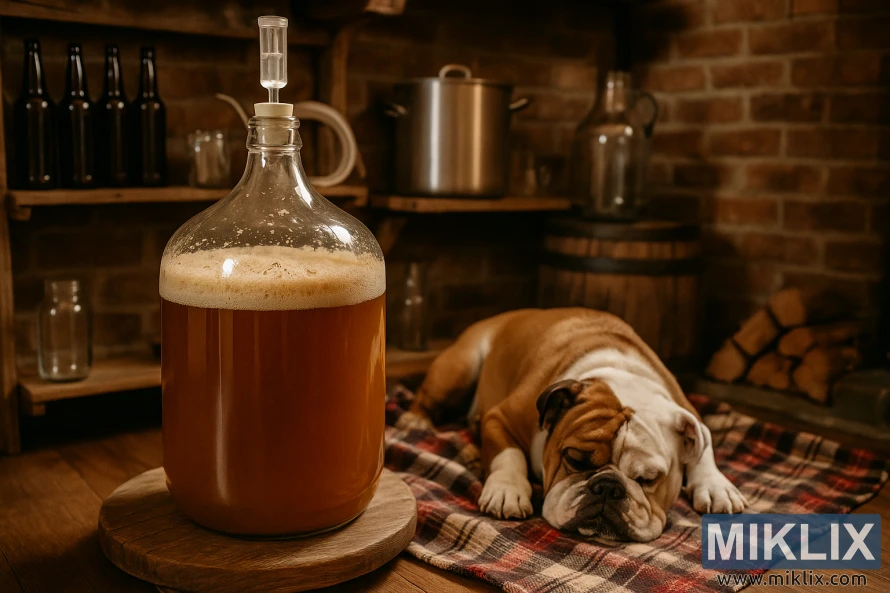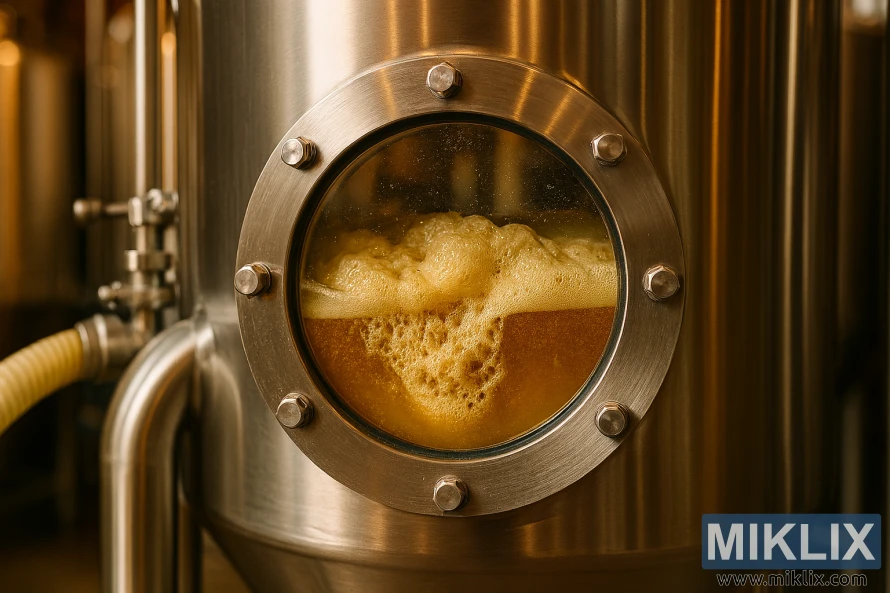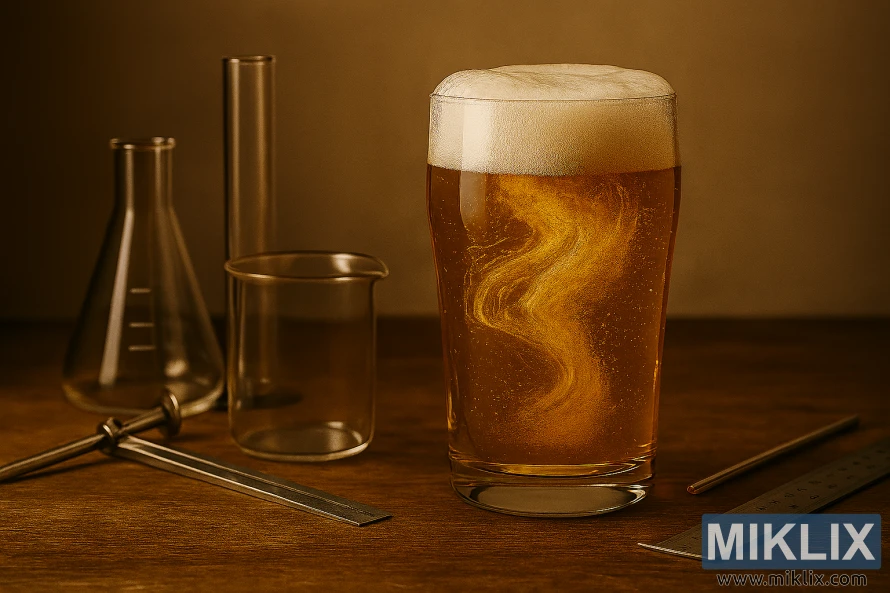Fermenting Beer with Bulldog B34 German Lager Yeast
Published: October 29, 2025 at 10:07:27 PM UTC
Bulldog B34 German Lager Yeast is a dry lager strain sold under the Bulldog Brews and Hambleton Bard labels. It's perfect for traditional German lagers and European-style pilsners. Many believe it's a repackaged version of Fermentis W34/70. This similarity is why homebrewers get consistent results when using B34 in various recipes and databases.

The yeast comes as a dry product, offering about 78% attenuation and high flocculation. It also has a practical alcohol tolerance for standard lagers. The ideal fermentation temperature is between the low single digits and mid-teens Celsius. This makes temperature control crucial for achieving clean, crisp flavors. Guides and analytics show Bulldog B34 is used in many recipes, from session lagers to fuller-bodied Märzens.
Repackaging by labs like Fermentis or Lallemand is common in the industry. Bulldog Brews B34 typically matches Fermentis W34/70's specifications. For brewers aiming for predictable attenuation and strong flocculation, Bulldog B34's performance data is invaluable. It helps in planning mash profiles and fermentation schedules.
Key Takeaways
- Bulldog B34 German Lager Yeast is a dry lager strain ideal for traditional German lagers.
- Many references equate Bulldog B34 to Fermentis W34/70, explaining similar performance.
- Expect ~78% attenuation, high flocculation, and a temp range near 9–14 °C.
- Common in published recipes and brewer databases; reliable for classic lager styles.
- Temperature control and proper pitching rates are key when fermenting with B34.
What is Bulldog B34 German Lager Yeast
Practically, Bulldog B34 is a commercial dry lager yeast. It's marketed as Bulldog (Hambleton Bard) German Lager with the code B34. Brewers often link its origin to the Fermentis W34/70 Weihenstephan lineage. This is under the Bulldog Brews German Lager identity.
The product is a dry yeast, making storage, transport, and pitching easier. This is compared to fragile liquid cultures. It's ideal for small breweries and homebrewers who value predictability and a stable shelf life.
It's commonly used for traditional German lagers and other European lager styles. These styles require a clean, crisp finish. Brewers also use it to achieve lager-like clarity in pale ales and hybrid recipes.
Packaging is crucial because many UK and European suppliers repack strains from Fermentis and Lallemand. Always check batch notes and technical sheets. This confirms specifics for each lot, as consistent specs are common but not guaranteed from batch to batch.
Key fermentation characteristics of Bulldog B34 German Lager Yeast
The Bulldog B34 profile is marked by a clean, neutral fermentation character. It accentuates malt and hop notes, making it ideal for traditional German lagers. This strain produces restrained esters, typical of Weihenstephan-type lagers.
B34 attenuation averages near 78.0%, leading to a dry finish. A 1.047 original gravity typically drops to about 1.010. This results in roughly 4.8% ABV when fermented to that level.
B34 flocculation is high, aiding in beer clarification during conditioning and lagering. The yeast settles well, ensuring a clearer pint after cold storage and time to compact the yeast cake.
The recommended fermentation temperature for B34 ranges from 9.0 to 14.0 °C. Many brewers opt for the narrower window of 8.9–13.9 °C. This helps maintain clean flavors and limits fruity byproducts.
Alcohol tolerance is moderate, making Bulldog B34 suitable for standard lager strengths. For very high-gravity lagers, increase pitch rates and nutrient additions to avoid stuck fermentation.
- Clean, neutral ester profile that showcases recipe ingredients.
- Reliable B34 attenuation for a crisp, dry mouthfeel.
- High B34 flocculation for faster clearing and brighter beer.
- Fermentation temp B34 range suitable for classic lager schedules.
Employ tight temperature control and proper pitching to maximize this strain's potential. This approach preserves the Bulldog B34 profile, ensuring consistent lager results batch after batch.

Why choose Bulldog B34 for traditional German lagers
Brewers seeking authentic German lagers opt for Bulldog B34. It offers a clean, neutral fermentation profile. This strain minimizes estery character, preserving the delicate malt and hop balance in Munich Helles and Dortmunder.
High attenuation ensures a dry, crisp finish, characteristic of classic lagers. This characteristic supports the authenticity of B34 lagers by avoiding lingering sweetness. The moderate body it produces is a key feature.
Strong flocculation enhances clarity and mouthfeel. Beers like Marzen benefit from this, achieving bright, glass-ready beer without the need for lengthy filtration. This reliability is why many brewers choose B34 for Marzen.
Predictability is crucial for consistent recipes. When sourced from reputable suppliers, Bulldog B34 behaves like documented lager strains like W34/70. This consistency makes it easier to reproduce results and follow recipes with confidence.
- Storage and handling: the dry format stores longer at home and in small breweries.
- Dosing: measuring and pitching dry yeast simplifies process control for consistent lagers.
- Versatility: suitable for Munich Helles, Pilsner, Märzen, and similar styles.
For brewers aiming for a dependable base culture, B34 lager authenticity and ease of use are key. It's a top choice for achieving a classic, restrained lager profile. Many experienced brewers prefer B34 for Marzen and Munich Helles, ensuring clean, predictable results.
Pitching rates and yeast handling for best results
Begin with a lager-specific target in mind. For most German lagers using Bulldog B34, aim for a pitching rate near 0.35 million cells per mL per °Plato. This rate is crucial to avoid slow starts and off-flavors, which can occur when fermenting at low temperatures.
Calculate the required cells for your batch size and gravity. For instance, a 20 L batch at 12°P might need several billion viable cells. Remember the Bulldog B34 pitch rate when ordering or planning your propagation.
Dry packets of this strain usually eliminate the need for a wet starter for standard-strength lagers. Opt for a dry yeast starter for B34 only for high-gravity beers or large-volume brews that require extra cell counts.
When preparing a starter or rehydrating, adhere to the manufacturer's rehydration steps. Use sterile water at the recommended temperature and ensure gentle aeration before pitching. Proper yeast handling B34 ensures rapid, healthy fermentation onset.
- Rehydrate per packet instructions when time allows.
- If pitching dry, distribute the yeast evenly across the wort surface.
- Oxygenate wort adequately to support the initial growth phase.
Store unopened packets in a cool, dry place and refrigerate as advised by vendors. Always check expiration dates and lot viability before use. Repacked or aged material may vary, so verify supplier specs against your required Bulldog B34 pitch rate.
Track viability with a simple viability test when scaling or reusing yeast. Good yeast handling B34, combined with the correct B34 pitching rate, will cut lag time, reduce stress, and enhance the lager's character.
Fermentation schedule and temperature control strategies
Begin your B34 fermentation in the 9–14 °C range. For traditional German lagers, aim for the mid-range, around 10–12 °C. This temperature range helps keep esters low and allows the yeast to ferment steadily.
Start at the cooler end for a cleaner flavor profile. A cooler start slows down fermentation, reducing the risk of off-flavors. If fermentation seems slow, slightly increase the temperature over 24 hours to encourage yeast activity without stressing it.
Plan a B34 diacetyl rest towards the end of attenuation. Raise the temperature to about 15–18 °C for 24–72 hours. This allows yeast to reabsorb diacetyl. Then, perform a crash-cool to prepare for long-term conditioning.
When controlling lager temperature B34, use gentle ramps. Gradually increase or decrease temperature by a few degrees daily, avoiding large jumps. This preserves yeast health and prevents unwanted sulfur or fusel notes.
- Typical timeline: active fermentation at 10–12 °C for 7–14 days.
- Diacetyl rest: 15–18 °C for 24–72 hours once near final gravity.
- Lagering: cold condition at near-freezing to low single-digit °C for several weeks to months.
Cold conditioning after the B34 diacetyl rest enhances clarity and flavor stability. Bulldog B34’s high flocculation aids in sedimentation during lagering, shortening the time to a clear beer.
If fermentation stalls, incrementally raise the temperature within the strain limits. Small, timed increases can reawaken yeast without causing hot-side ester spikes. Monitor gravity daily to time the diacetyl rest correctly.
Consistent thermostat control and reliable fermentation chambers are crucial for lager temperature control B34. Use calibrated thermometers and avoid sudden drafts to ensure a predictable and repeatable schedule.
Water, malt, and hop considerations when using Bulldog B34
Begin with a balanced, moderately soft water profile for B34 to capture the essence of classic German lager. Adjust the chloride to sulfate ratio to enhance either malt presence or hop crispness, depending on your desired style.
For malt choices, B34 excels with a pale Pilsner or Pilsner malt base. Incorporate Munich or Vienna malts for added depth. A small portion of specialty crystal, like 10–20 L at low percentages, helps maintain color and sweetness balance.
- Use a lower mash temperature (148–152°F) for a drier finish that showcases Bulldog B34’s high attenuation.
- Raise mash to 154–156°F to retain more body if aiming for balance in a stronger lager.
- Keep specialty malts under 10% to avoid overshadowing the clean yeast character.
Opt for hops that complement German lager styles: Hallertauer Mittelfrüh, Tettnang, or Saaz for their delicate floral and spicy notes. Low-to-moderate IBUs are ideal, allowing malt and yeast to take center stage.
When crafting a recipe for Bulldog B34, remember its neutral ester profile. Let the malt and hops guide the aroma and flavor. Opt for minimal late additions and dry hopping to maintain traditional lager character.
- Water: aim for a soft, balanced profile and tweak chloride/sulfate to taste.
- Malts: base Pilsner malt with a modest Munich addition and light specialty malts.
- Hops: noble German varieties at low-to-moderate rates to preserve elegance.
Balance is crucial since Bulldog B34 tends to finish dry. Design your malt choices around desired body and set mash temps to control residual sugars. This approach ensures a clean, crisp lager where water profile, hops, and recipe for Bulldog B34 harmonize.

Common recipes and real-world examples using Bulldog B34
Bulldog B34 recipes excel in classic German and Central European lagers. BrewersFriend showcases a representative all-grain Pilsner. It finishes clean, with an Original Gravity near 1.047 and Final Gravity close to 1.010. This recipe uses mainly Pale Ale malts, with a hint of Crystal 15L for gentle color and roundness.
Beer-Analytics lists numerous B34 beer examples across various styles. Common styles include Pilsner, Munich Helles, Dortmunder Export, Märzen, and Vienna lager. Each recipe emphasizes a simple grain bill, modest hopping, and extended cold conditioning. This highlights the strain's neutral, crisp profile.
Recipes for Bulldog B34 often involve dry yeast pitched directly, without a starter, at an optimal temperature of about 8.9–13.9 °C. The target pitching rate is roughly 0.35 million cells per milliliter per degree Plato. This balance supports the reported 78% attenuation and high flocculation seen in published formulas.
Real-world B34 use demonstrates consistency when scaling recipes to larger batches. Large-batch examples caution about water volumes and mash tun capacity. Adapting equipment profiles, such as mash thickness and recirculation, ensures efficiency remains predictable as batch size increases.
- Simple Pilsner: pale malts, low hopping, cold lager for 4–8 weeks. This yields a crisp, dry finish.
- Munich Helles: richer malt bill, soft water, gentle noble hops. B34 preserves malt sweetness without adding esters.
- Vienna or Märzen: modest crystal or Vienna malts for color and backbone. Extended conditioning smooths the profile.
When testing B34 beer examples at home, closely track OG and FG. Adjust fermentation temperature in small steps. This approach ensures a predictable final gravity and showcases the clean, balanced character brewers expect from Bulldog B34.
Managing attenuation and final gravity with Bulldog B34
Bulldog B34 typically reaches around 78% attenuation, leading to a low final gravity in many lagers. For instance, an OG of 1.047 often finishes near FG 1.010. This is when the mash and fermentation are set for high fermentability.
To influence body and sweetness, adjust the mash schedule. Raise mash temperature or add dextrin malts to increase residual sugars. This raises the final gravity B34. Lower mash temps create more fermentable wort and a drier finish, matching B34’s natural tendency toward high attenuation.
Proper yeast handling is key to achieving target attenuation. Pitching the right cell count and providing oxygen at wort chill promote healthy fermentation. Stressed or underpitched yeast can stall early, leaving a higher FG than expected.
Monitor gravity frequently during active fermentation. If fermentation stalls above target, try small, controlled temperature rises to coax activity. Early oxygenation and yeast nutrient can prevent stalls; late oxygen addition can harm flavor, so avoid it after growth begins.
- Check pitch rate and rehydrate or build a starter for older or low-count packets.
- Use mash adjustments to set expected fermentability before fermentation starts.
- Measure gravity twice a day during the active phase to confirm.
When taking corrective steps, keep records. Tracking mash temp, OG, and measured gravities helps refine B34 attenuation control over future brews. Small, consistent changes yield predictable final gravity B34 and a beer profile that matches your recipe goals.

Flocculation and clarification techniques for crystal-clear lagers
Bulldog B34's fame is built on its exceptional B34 flocculation. This strain clumps and settles rapidly after fermentation. This natural process simplifies the clarification of lagers for both homebrewers and small breweries.
Start with a gentle cold crash to enhance yeast settling Bulldog B34. Lower the temperature to near freezing for 24–72 hours. The sudden drop in temperature aids in the settling of remaining yeast and haze particles.
Post-fermentation, handle the beer with care. Transfer the beer to a secondary or bright tank, avoiding the settled yeast. Allow the yeast to settle further before packaging.
For those aiming for commercial-grade clarity, consider fining or filtration. Isinglass or PVPP can be used to expedite the clarification of lagers. Filtration ensures consistent clarity, even under tight production schedules.
- Depend on cold conditioning and time for cost-effective results.
- Use finings sparingly to avoid stripping delicate malt and hop character.
- When filtering, match pore size to target haze and flavor preservation.
Extended lagering at near-freezing temperatures enhances B34 flocculation benefits. A longer cold rest allows proteins and polyphenols to bind and settle, improving clarity and shelf stability.
Keep detailed records of each batch. Note how clarifying lager B34 responds to different lagering lengths, fining doses, and filtration steps. This record will help refine the right lager clarity techniques for your setup.
Alcohol tolerance and limits: what to expect
The Bulldog B34 ABV limit falls into the medium category. Manufacturer guidelines and repack identification suggest it's suitable for classic lagers with an ABV of 4–6%. Brewers have found consistent attenuation in recipes like a 4.8% example from BrewersFriend.
B34 alcohol tolerance handles everyday lager strengths with ease. For higher ABV targets, it's crucial to protect yeast health. Increasing the pitch rate and ensuring sufficient oxygen at the start can reduce fermentation stress.
When dealing with high gravity, B34 requires extra caution. Consider staged sugar additions or step-feeding to avoid osmotic shock. Yeast nutrient and strong aeration are also key to keeping cells active when wort gravity exceeds typical lager levels.
- Pitch higher cell counts for stronger worts.
- Oxygenate thoroughly before pitching.
- Add nutrient and consider staggered sugar feeds.
Expecting to push the Bulldog B34 ABV limit without proper preparation can lead to stuck fermentation or off-flavors. For very high ABV lagers, consider high-tolerance strains like certain Saccharomyces bayanus or specialized distilling yeasts as alternatives.
In typical homebrew practice, B34 alcohol tolerance meets the needs of traditional German-style lagers. Treat it as a reliable lager strain that rewards proper pitching, oxygenation, and nutrient management when brewing high gravity with B34.

Troubleshooting common fermentation issues with Bulldog B34
To troubleshoot B34, start by checking basic variables. Measure specific gravity and compare to expected attenuation near 78%. Note fermentation temperature, pitch rate, and how soon bubbling began.
Stuck fermentation Bulldog B34 often stems from underpitching, low temps, poor oxygenation, or nutrient shortfalls. Take incremental steps to revive activity rather than dramatic changes that stress yeast.
- Raise temperature slowly within the strain's tolerance; a few degrees can restart activity.
- Oxygenate only early in fermentation. Late oxygen additions risk oxidation.
- The correct pitch rate matters. Use a starter or add extra packs for larger batches.
- Add a yeast nutrient if you suspect a deficiency, specially with high-gravity worts.
B34 off-flavors typically show as diacetyl or subtle esters when fermentation is too cool or ends prematurely. Diacetyl appears as a buttery note that brightens with time when yeast can reabsorb it.
To fix diacetyl B34, perform a diacetyl rest by raising the beer to about 15–18 °C (59–64 °F) for 24–72 hours. Let the yeast clean up diacetyl, then re-cool to lager temperatures for conditioning.
If performance still lags, check packet date codes and supplier reputation. Poor viability can come from old or improperly stored packs. Sourcing fresh Bulldog B34 or switching vendor may resolve chronic issues.
- Confirm gravity and temps, then gently warm the fermenter if needed.
- Provide oxygen only at yeast uptake stage and consider nutrient additions.
- Repitch with active yeast or a starter when viability is doubtful.
- Use a diacetyl rest to remove buttery off-notes and allow proper conditioning.
Follow these steps to troubleshoot B34 and reduce the chance of stuck fermentation Bulldog B34 or persistent B34 off-flavors. Small, measured interventions preserve beer quality and keep your lager on track.
Comparisons and alternatives to Bulldog B34 German Lager Yeast
Homebrewers frequently seek direct comparisons to select the ideal strain for their recipes. The debate between B34 and W34/70 is prevalent, given that many repackaged packets contain the Weihenstephan strain from Fermentis. These strains share similar specs for attenuation, flocculation, and temperature ranges, leading to comparable flavor outcomes in clean lagers.
Exploring Bulldog B34 alternatives reveals Fermentis S-189 and Lallemand Diamond as viable options. S-189 presents a slightly fruitier ester profile. In contrast, Lallemand Diamond boasts higher alcohol tolerance and stronger flocculation. Each strain influences mouthfeel and subtle aroma, making it crucial to choose based on style goals rather than brand loyalty.
When comparing yeast strains, focus on technical sheets rather than labels. Key metrics include attenuation percent, optimal fermentation range, and flocculation behavior. These numbers are more indicative of performance than packaging. Given that many household brands repack major producers' strains, a data-driven approach is essential for best lager yeast comparisons.
Consider these selection criteria:
- Neutral lagers: stick with B34 or W34/70 for classic, clean character.
- Estery lagers: choose S-189 or other strains that produce more esters.
- High-gravity lagers: prefer Diamond or other high-tolerance strains.
For trials, split batches and ferment the same wort with two strains. Tasting side-by-side clarifies differences faster than reading specs alone. Keep records of pitch rate and temperature to repeat successes.
Practical tips for homebrewers and scale-up considerations
Plan your pitch with a reliable calculator. Large batches require accurate cell counts. A recipe using 0.35 million cells/ml/°P will underpitch most beers. Use BrewersFriend or a similar tool to compute yeast quantities before you buy or rehydrate.
Follow manufacturer directions for rehydration or direct pitch. Keep packets cool and dry during storage. Older packs lose viability, so perform a viability check when scaling. These simple B34 homebrewing tips protect fermentation performance.
- For pitching large batches B34, split the pitch across multiple starters if needed to reach target cell counts.
- Ensure vigorous aeration on high-gravity or large-volume boils to support healthy yeast growth.
Confirm vessel capacities before brewing. Large recipes often trigger equipment warnings when mash tun or kettle volumes are tight. Review strike water, mash, and boil-off volumes so you do not exceed mash tun limits or flood burners.
When scaling Bulldog B34, test run water and grain volumes on paper and in practice. Check pump flow rates and kettle clearance to avoid boilovers and stuck mashes. Equipment notes for lagering should include chillers and cold-room capacity planning.
Lagering needs reliable cold storage. You must hold near-freezing temps for weeks to achieve clarity and flavor. For home setups, use temperature controllers or chest freezers with external probes. For commercial scale, glycol systems provide steady control.
- Compare suppliers for cost and lot specs when sourcing dry Bulldog B34. Lot variation affects flavor and viability.
- Keep spare packs or frozen yeast backups to maintain production schedules and repeatability.
- Document each batch so you can refine pitching large batches B34 and adjust for attenuation differences.
Record lessons learned after each brew. Notes on mash efficiency, oxygenation volumes, and ferment times make scaling Bulldog B34 smoother over time. Good documentation turns one-off success into repeatable quality.
Conclusion
Bulldog B34 conclusion: this dry lager strain is perfect for traditional German and European lagers. It offers around 78% attenuation and high flocculation. This results in clean, crisp beers with excellent clarity. Homebrewers will find the dry format convenient, as it stores and handles well.
This review Bulldog B34 highlights its strengths and limitations. Its reliable attenuation and fast settling preserve malt and hop character. Yet, it has a medium alcohol tolerance, limiting its use in very high-gravity lagers. It's also important to verify supplier documentation, as B34 might be a repack of known strains like Fermentis W34/70.
B34 recommendation: choose Bulldog B34 for a neutral, straightforward lager profile and a bright, finished beer. For high-ABV projects or specific ester profiles, consider other lager strains. Adjust the pitch rate, oxygenation, and temperature schedule as needed. Overall, Bulldog B34 is a reliable pick for clean, authentic lagers in home and small-scale brewing.
Further Reading
If you enjoyed this post, you may also like these suggestions:
- Fermenting Beer with White Labs WLP095 Burlington Ale Yeast
- Fermenting Beer with Lallemand LalBrew Munich Classic Yeast
- Fermenting Beer with White Labs WLP066 London Fog Ale Yeast
